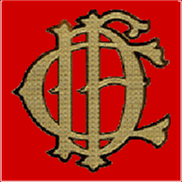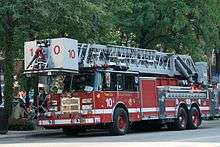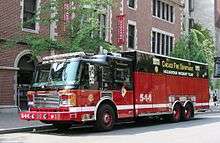Chicago Fire Department
 | |
| "We're There When You Need Us" | |
| Operational area | |
|---|---|
| Country |
|
| State |
|
| City |
|
| Agency overview | |
| Established | August 2, 1858 |
| Annual calls | 739,867 (2013) |
| Employees | 5,143 |
| Commissioner | Jose A. Santiago |
| EMS level | ALS |
| IAFF | 2 |
| Facilities and equipment | |
| Divisions | 5 |
| Battalions | 24 |
| Stations | 98 (Including 1 Fireboat Station) |
| Engines | 96 |
| Trucks | 61 |
| Squads | 4 |
| Ambulances | 75 ALS |
| HAZMAT | 2 |
| Helicopters | 2 |
| Fireboats | 2 |
| Website | |
|
www | |
|
www | |
The Chicago Fire Department (CFD) provides fire suppression and emergency medical services to the city of Chicago, Illinois, United States, under the jurisdiction of the Mayor of Chicago. The Chicago Fire Department is the third largest municipal fire department in the United States after the New York City Fire Department and Cal Fire, as measured by sworn personnel. It is also one of the oldest major organized fire departments in the nation.
The Chicago Fire Department is led by the Fire Commissioner, who is Jose A. Santiago. The Fire Commissioner is appointed by the Mayor. The Fire Commissioner is assisted by the First Deputy Commissioner, who is Charles Stewart III, who oversees the department's bureaus. There are four bureaus under the First Deputy Commissioner: Operations, Fire Prevention, Administrative Services & Logistics.
The Chicago Fire Department receives over 500,000 emergency calls annually.
Organization

Bureaus
There are four Bureaus of Operation within the Chicago Fire Department: Operations, Administrative Services, Logistics and Fire Prevention. The four Bureaus are commanded by the 1st Deputy Fire Commissioner, Charles Stewart III, who in turn reports to the Fire Commissioner.
Operations
The Bureau of Operations is the largest Bureau within the Chicago Fire Department. The Bureau of Operations commands the following Divisions: Fire Suppression & Rescue, Emergency Medical Services (EMS), Special Operations, and the Office of Fire Investigation (OFI). The Bureau of Operations is composed of over 4,500 Firefighters and Paramedics and is commanded by a Deputy Fire Commissioner.[1]
Administrative Services
The Bureau of Administrative Services commands the following Divisions: Personnel, Training, the Photo Unit, and the Employee Assistance Program. Administrative Services is commanded by a Deputy Fire Commissioner.[2]
Logistics
The Bureau of Logistics commands the following Divisions: Support Services, Support & Logistics(EMS), Equipment & Supply, Building & Property Management, Record, Employee Relations, Labor Relations, Staff/Human Relations, the Pension Board, the Regulatory Compliance, and Management Information Systems/Technology. The Bureau of Logistics is commanded by a Deputy Fire Commissioner.[3]
Fire Prevention
The Bureau of Fire Prevention commands the following Divisions: Code Compliance and Inspections. Fire Prevention is commanded by a Deputy Fire Commissioner.[4]
Operations
The Bureau of Operations is one of four Bureaus within the organization of the Chicago Fire Department. Like the other three Bureaus, the Bureau of Operations is commanded by a Deputy Fire Commissioner, who reports to the 1st Deputy Commissioner, who in-turn reports to the Fire Commissioner. The Bureau of Operations is currently the largest Bureau within the Chicago Fire Department and is organized into four Divisions: Fire Suppression and Rescue, Emergency Medical Services (EMS), Special Operations (including the Technical Rescue Unit, the Hazardous Materials Unit, and the Air-Sea Rescue Unit), and the Office of Fire Investigation (OFI). The Fire Suppression and Rescue Division is commanded by an Assistant Deputy Fire Commissioner. The Special Operations Division and the EMS Division are also commanded by an Assistant Deputy Commissioner. The Office of Fire Investigation (OFI) is under the command of the Commanding Fire Marshall, equivalent to the rank of Deputy District Chief. [1][5]

Fire Suppression and Rescue Division
The Fire Suppression and Rescue Division is commanded by an Assistant Deputy Fire Commissioner (radio call sign: 2-1-10). The Division consists of five Fire Districts, each commanded by a District Chief. Within the five Districts are 24 Battalions, each commanded by a Battalion Chief per shift, who reports to the Deputy District Chief of the District, who in-turn reports to the District Chief of the District.

Emergency Medical Services (EMS)
The Emergency Medical Services (EMS) Division is commanded by an Assistant Deputy Fire Commissioner (2-1-11). The Division consists of two Field Divisions, the North Division, and the South Division. Each Division is commanded by an Assistant Deputy Chief Paramedic per shift. The two Assistant Deputy Chief Paramedics report to the Assistant Deputy Fire Commissioner of the Division. Within the two Field Divisions, there are eight EMS Districts. Each EMS District is under the command of a Paramedic Field Chief. Each EMS District's Paramedic Field Chief is in charge of all EMS and Ambulance Companies within that District.
Special Operations
The Special Operations Division is commanded by an Assistant Deputy Commissioner (2-1-9) and is divided into several subsections, including Hazardous Materials (Haz-Mat.) and Air-Sea Rescue. The Haz-Mat. subdivision is commanded by a Deputy District Chief (5-1-0). The Air Sea Rescue subdivision is commanded by two Deputy District Chiefs, one in charge of Air Operations (6-8-0), and one in charge of SCUBA Operations (6-8-6). Within the Special Operations Division is the Special Operations Battalion (5-1-5). Similar to a Fire Battalion, the Special Operations Battalion is in charge of all the specialized units and companies within the Chicago Fire Department. The on-duty Special Operations Battalion Chief reports to the Assistant Deputy Commissioner of the Division, as well as the Haz-Mat., SCUBA, and Air Operations Deputy District Chiefs.
Companies and units (2016)



Fire Station Locations and Apparatus
The Chicago Fire Department is organized into 5 Districts, which command a total of 24 Battalions and a Special Operations Battalion.[6][7] The
Communications
The Chicago Fire Department operates two fire alarm frequencies: Main and Englewood. Main covers the city north of the South Branch of the Chicago River and Englewood covers the city south of the same point. The 2 EMS frequencies are mirrored in both name and boundaries. The separate designations are from when the Englewood Fire Alarm office was located at 64th and Wentworth Streets, and the Main Fire Alarm Office which was located on the fifth floor of Chicago City Hall, at 121 North LaSalle Street. Both offices merged into one location at the city's 911 Center in 1996, located at Madison and Laflin Streets.
Alarm assignments
Still Alarms
A Still Alarm, is the basic structure fire response protocol of the Chicago Fire Department. The term "Still Alarm" came about upon the advent of telephones becoming more prevalent in reporting emergencies. The alarm office's register that received the signals from the actual fireboxes would remain "still" when someone reported a fire or emergency via telephone. The Still & Box is either transmitted by companies upon arrival at the scene when needed or due to multiple reports or confirmation of a fire. If there is a confirmed fire, the Still & Box Assignment may be added to the "Still" or "High-Rise Still" assignment upon request of the ranking officer on the scene. The Rapid Intervention Team (R.I.T.) Response is sent when the "Still" becomes a working fire, or upon request. The Mayday Assignment is used when firefighters operating on the scene of any emergency become lost, trapped or are discovered to be missing. Any member of the Chicago Fire Department of any rank or title operating on the scene of an emergency is authorized to call for a Mayday response if they so feel the need.
| Alarm Type | Alarm Level | Units Assigned |
|---|---|---|
| Still Alarm | 1st Alarm | 2 Engines, 2 Trucks, 1 Battalion Chief (Still) |
| Full Still Alarm | 1st Alarm, Working Fire *Upgrade* | 1 Truck (R.I.T.), 1 Battalion Chief (R.I.T.), 1 Squad, 1 Command Van, 2 ALS Ambulances (1 R.I.T/Standby.), 1 Paramedic Field Chief (R.I.T.) |
| Full Still Alarm | 1st Alarm, Working Fire in a Red "X" Building *Upgrade* | 1 Truck (1 R.I.T.), 3 Battalion Chiefs (1 R.I.T., 1 Safety, 1 Special Operations), 1 Deputy District Chief, 1 Squad, 1 Command Van, 1 O.F.I. Unit, 2 ALS Ambulances (1 R.I.T.), 1 Paramedic Field Chief (R.I.T.) |
| Still Alarm in a High-Rise Building | 1st Alarm | 4 Engines, 4 Trucks (1 R.I.T.), 3 Battalion Chiefs (1 Still, 1 R.I.T., 1 Fire Attack, 1 High-Rise), 1 Squad, 1 Command Van, 1 ALS Ambulance, 1 Paramedic Field Chief |
| Mayday Alert | 1st Alarm, Mayday Alert *Box or 2-11 Auto Upgrade* | 1 Truck (R.I.T.), 1 Battalion Chief (R.I.T.), 1 Squad, 3 ALS Ambulances (1 R.I.T.), 1 Paramedic Field Chief (R.I.T.), 1 Bottle Truck, 1 Light Wagon, Collapse Rescue Team (Engine 5, Truck 2, 5-2-1) |
Box Alarms
Box Alarms are the other main assignment utilized by the Chicago Fire Department. A Box Alarm is the standard protocol response for fire alarm activations in a hospital, nursing home, theater or other potentially high risk structure. If the fire is reported to have persons trapped or the Fire Alarm Office receives numerous calls for the same location, then a "Still & Box Alarm" is automatically transmitted by Fire Alarm Office.
| Alarm Type | Alarm Level | Units Assigned |
|---|---|---|
| Box Alarm | 1st Alarm | 4 Engines, 2 Trucks, 1 Battalion Chief (Box) |
| Still & Box Alarm | 1st Alarm, Still *Upgrade* | 4 Engines, 3 Trucks (1 R.I.T.), 1 Tower Ladder, 4 Battalion Chiefs (1 Box, 1 R.I.T., 1 Safety, 1 Fire Attack), 1 Deputy District Chief, 1 Squad, 1 Command Van, 1 O.F.I. Unit, 2 ALS Ambulances (1 R.I.T.), 2 Paramedic Field Chiefs (1 R.I.T.) |
| Still & Box Alarm in a High-Rise Building | 1st Alarm, High-Rise Still *Upgrade* | 1 Engine (ALS), 3 Battalion Chiefs (1 Plans, 1 Safety), 1 Helicopter (6-8-1 or 6-8-2), EMS Plan I Assignment |
Multiple Alarms
Higher-alarms for larger fires and more serious incidents are assigned as 2nd, 3rd, 4th, and 5th Alarm Assignments as upgrades of a "Still & Box", a "Box", or a "Working Fire". Each alarm level is signified by the level of alarms, followed by the number 11. The number "11" after the level of alarm is tradition of the bell and register system striking 11 blows onto the bell in the firehouse after whatever level of alarm the incident has been upgraded to, followed by the box number, carried over into the modern era.
| Alarm Type | Alarm Level | Units Assigned |
|---|---|---|
| 2-11 Alarm | 2nd Alarm *Upgrade* | 4 Engines, 2 Trucks, 1 Tower Ladder, 2 Battalion Chiefs, 1 Deputy District Chief, 1 Air Mask Service Bottle Truck, 1 Light Wagon Unit, Media Affairs Unit, 2-7-10, 6-3-9 |
| 3-11 Alarm | 3rd Alarm *Upgrade* | 4 Engines, 1 Deputy Fire Commissioner, 1st Deputy Fire Commissioner |
| 4-11 Alarm | 4th Alarm *Upgrade* | 4 Engines, Fire Commissioner |
| 5-11 Alarm | 5th Alarm *Upgrade* | 4 Engines |
| Special Alarm | (any level) *Upgrade* | any additional units not part of an existing alarm profile; may be specialized units such as turret wagons, mobile ventilators, extra line units, or the reserve snorkel (6-6-1); at discretion of IC |
Special Incidents
Special Incidents are incidents handled by the Chicago Fire Department that are emergencies other than fires. While a Still & Box Alarm might be used for an 'L' train derailment, a Water Rescue or a Collapse Rescue has its own assignment. Many of these assignment profiles include specialized units not ordinarily found at the scene of a fire; being part of a named preplanned response, they are not considered "Specials". However, as with fires, units not listed in the default responses below can be special-called to the incident scene, designated by their signature number (i.e., Unit 6-8-2 is one of the CFD's Air-Sea Rescue Helicopters). The additional vehicle(s) are referred to as "Specials", while the incident type is specified. Thus, if a Mobile Ventilation Unit (MVU) were called to a Building Collapse, it would be described as "Building Collapse response with one Special".
CFD's Special Operations division has a Battalion Chief dedicated to it (5-1-5), who will always be among the chiefs dispatched to a special incident.
| Alarm Type | Alarm Level | Units Assigned |
|---|---|---|
| Motor Vehicle Accident (MVA) | Special | 1 Engine or 1 Truck, 1 Ambulance |
| Motor Vehicle Accident (MVA) with Entrapment | Special | 1 Engine, 1 Truck, 1 Battalion Chief, 1 Squad, 1 Ambulance, 1 Paramedic Field Chief |
| Vehicle Fire | Special | 1 Engine |
| Expressway Vehicle Fire | Special | 2 Engines, 1 Truck, 1 Battalion Chief |
| Specialty Rescue | Special | 1 Engine, 1 Truck, 1 Battalion Chief, 1 Squad, 1 Ambulance, 1 Paramedic Field Chief |
| Building Collapse | Special | 5 Engines, 3 Trucks, 1 Tower Ladder, 3 Battalion Chiefs, 1 Deputy District Chief, 1 Squad, 1 Command Van, 1 Ambulance, 1 Paramedic Field Chief, 1 O.F.I. Unit, 1 Collapse Rescue Unit |
| Water Rescue | Special | 1 Engine, 1 Truck, 1 Battalion Chief, 1 Squad, 1 Ambulance, 1 Fireboat, 1 Helicopter, 1 SCUBA Team Unit, 1 Fast Boat |
EMS plans
Because the Chicago Fire Department handles the city's Emergency Medical Services, certain large-scale incidents, such as a major vehicle accident or a building collapse will require a special EMS Response. This response is also known as a "Plan" from the CFD's EMS Division. These plans consist of EMS Units and Fire Units, depending on the incident. EMS Plans can also be assigned to fires where a large EMS presence is needed or special events, such as a marathon where injuries may arise.
| Alarm Type | Alarm Level | Units Assigned |
|---|---|---|
| EMS Plan I | EMS Plan | 5 Ambulances, 1 Paramedic Field Chief, 1 Assistant Deputy Chief Paramedic, 1 Engine or 1 Truck (ALS), 1 Battalion Chief |
| EMS Plan II | EMS Plan *Upgrade* | 5 Ambulances, 1 Paramedic Field Chief, 1 Deputy District Chief, 1 Command Van, 1 Triage Van, Media Affairs Unit |
| EMS Plan III | EMS Plan *Upgrade* | 5 Ambulances, 1 Assistant Deputy Fire Commissioner (EMS), 1 on-call Physician, 1 District Chief, 5 |
Hazardous Materials Incidents
During a Hazardous Materials (Haz-Mat.) Incident, such as a chemical spill or leak, the Chicago Fire Department assigned three specific levels of response depending on the size and magnitude of the incident. Aside from standard fire suppression equipment and Haz-Mat. equipment, the CFD also can dispatch standard fire suppression equipment whose crews have special training in hazardous materials situations and mitigation. These companies are called the Hazardous Incident Team (H.I.T.).
| Alarm Type | Alarm Level | Units Assigned |
|---|---|---|
| Level I Haz-Mat. | Haz-Mat. Incident | 1 Engine, 1 Truck, 1 Battalion Chief, 1 Ambulance, 1 Haz-Mat. Unit |
| Level II Haz-Mat. | Haz-Mat. Incident *Upgrade* | 1 Engine (H.I.T.), 1 Truck (H.I.T.), 2 Battalion Chiefs (Plans, Safety) 1 Special Operations Chief (5-1-5), 1 OFI unit, 1 Deputy District Chief, 1 Command Van, 1 Paramedic Field Chief, 1 Air Mask Service Bottle Truck |
| Level III Haz-Mat. | Haz-Mat. Incident *Upgrade* | 1 Haz-Mat. Unit, 1 Deputy District Chief (Haz-Mat.) |
Popular culture
The Chicago Fire Department cooperated with film director Ron Howard on making the 1991 film Backdraft, starring Kurt Russell, William Baldwin, and Robert De Niro.
The NBC television show Chicago Fire, which centers on a group of fictional firefighters and paramedics at a firehouse that is the headquarters of the fictitious Engine Company 51, Truck Company 81, Rescue Squad Company 3, and Ambulance 61 (represented by the headquarters for real Engine Company 18).[8]> CFD firefighters were involved in the production as consultants or extras and real places in the city were often referenced in the characters' dialog.
See also
References
- 1 2 "City of Chicago :: Operations". Cityofchicago.org. Retrieved 18 January 2015.
- ↑ "City of Chicago :: Administrative Services". Cityofchicago.org. Retrieved 18 January 2015.
- ↑ "City of Chicago :: Employee Relations". Cityofchicago.org. Retrieved 18 January 2015.
- ↑ "City of Chicago :: Fire Prevention". Cityofchicago.org. Retrieved 18 January 2015.
- ↑ "Chicago Fire Department Organizational Chart" (PDF). Cityofchicago.org. Retrieved 18 January 2015.
- ↑ "Radio Station Identification Numbers" (PDF). Chicagofd.org. Retrieved 18 January 2015.
- ↑ "Chicago Fire Dept - Districts & Battalions". Plaws.net. Retrieved 18 January 2015.
- ↑ "GREC Architects Chicago Fire Department".